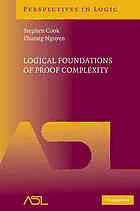
Perspectives in logic: logical foundations of proof complexity PDF
Preview Perspectives in logic: logical foundations of proof complexity
LogicalFoundationsofProofComplexity This book treats bounded arithmetic and propositional proof complexity from the point of view of computational complexity. The first seven chapters include thenecessarylogicalbackgroundforthematerialandaresuitableforagraduate course. Associatedwitheachofmanycomplexityclassesarebothatwo-sortedpred- icate calculus theory, with induction restricted to concepts in the class, and a propositionalproofsystem.ThecomplexityclassesrangefromAC0fortheweak- est theory up to the polynomial hierarchy. Each bounded theorem in a theory translatesintoafamilyof(quantified)propositionaltautologieswithpolynomial sizeproofsinthecorresponding proofsystem.Thetheoryprovesthesoundness oftheassociatedproofsystem. Theresultisauniformtreatmentofmanysystemsintheliterature,including Buss’s theories for the polynomial hierarchy and many disparate systems for complexityclassessuchasAC0,AC0(m),TC0,NC1,L,NL,NC,andP. Stephen Cook is a professor at the University of Toronto. He is author of many researchpapers,includinghisfamous1971paper“TheComplexityofTheorem ProvingProcedures,”andthe1982recipientoftheTuringAward.Hewasawarded a Steacie Fellowship in 1977 and a Killam Research Fellowship in 1982 and received the CRM/Fields Institute Prize in 1999. He is a Fellow of the Royal SocietyofLondonandtheRoyalSocietyofCanadaandwaselectedtomembership intheNationalAcademyofSciences(UnitedStates)andtheAmericanAcademy ofArtsandSciences. PhuongNguyenisapostdoctoralresearcheratMcGillUniversity.Hereceivedhis MScandPhDdegreesfromUniversityofTorontoin2004and2008,respectively. He has been awarded postdoctoral fellowships by the Eduard Cˇech Center for Algebra and Geometry (the Czech Republic) and by the Natural Sciences and EngineeringResearchCouncilofCanada(NSERC). PERSPECTIVES INLOGIC ThePerspectivesinLogicseriespublishessubstantial,high-qualitybookswhose centralthemeliesinanyareaoraspectoflogic.Booksthatpresentnewmaterial notnowavailableinbookformareparticularlywelcome.Theseriesrangesfrom introductory texts suitable for beginning graduate courses to specialized mono- graphs at the frontiers of research. Each book offers an illuminating perspective foritsintendedaudience. The series has its origins in the old Perspectives in Mathematical Logic series editedbythe(cid:2)-Groupfor“MathematischeLogik”oftheHeidelbergerAkademie derWissenchaften,whosebeginningsdatebacktothe1960s.TheAssociationfor SymbolicLogichasassumededitorialresponsibilityfortheseriesandchangedits nametoreflectitsinterestinbooksthatspanthefullrangeofdisciplinesinwhich logicplaysanimportantrole. PavelPudlak,ManagingEditor MathematicalInstituteoftheAcademyofSciencesoftheCzechRepublic EditorialBoard MichaelBenedikt DepartmentofComputingScience,UniversityofOxford MichaelGlanzberg DepartmentofPhilosophy,UniversityofCalifornia,Davis CarlG.Jockusch,Jr. DepartmentofMathematics,UniversityofIllinoisatUrbana-Champaign MichaelRathjen SchoolofMathematics,UniversityofLeeds ThomasScanlon DepartmentofMathematics,UniversityofCalifornia,Berkeley SimonThomas DepartmentofMathematics,RutgersUniversity ASLPublisher RichardA.Shore DepartmentofMathematics,CornellUniversity Formoreinformation,seehttp://www.aslonline.org/books perspectives.html PERSPECTIVESINLOGIC Logical Foundations of Proof Complexity STEPHEN COOK UniversityofToronto PHUONG NGUYEN McGillUniversity association for symbolic logic CAMBRIDGE UNIVERSITY PRESS Cambridge, New York, Melbourne, Madrid, Cape Town, Singapore, São Paulo, Delhi, Dubai, Tokyo Cambridge University Press The Edinburgh Building, Cambridge CB2 8RU, UK Published in the United States of America by Cambridge University Press, New York www.cambridge.org Information on this title: www.cambridge.org/9780521517294 © Association for Symbolic Logic 2010 This publication is in copyright. Subject to statutory exception and to the provision of relevant collective licensing agreements, no reproduction of any part may take place without the written permission of Cambridge University Press. First published in print format 2010 ISBN-13 978-0-511-67716-8 eBook (NetLibrary) ISBN-13 978-0-521-51729-4 Hardback Cambridge University Press has no responsibility for the persistence or accuracy of urls for external or third-party internet websites referred to in this publication, and does not guarantee that any content on such websites is, or will remain, accurate or appropriate. CONTENTS Preface.......................................................... xiii ChapterI. Introduction...................................... 1 ChapterII. ThePredicateCalculusandtheSystemLK....... 9 II.1. PropositionalCalculus............................... 9 II.1.1. Gentzen’sPropositionalProofSystemPK............. 10 II.1.2. SoundnessandCompletenessofPK .................. 12 II.1.3. PK ProofsfromAssumptions......................... 13 II.1.4. PropositionalCompactness........................... 16 II.2. PredicateCalculus................................... 17 II.2.1. SyntaxofthePredicateCalculus...................... 17 II.2.2. SemanticsofPredicateCalculus....................... 19 II.2.3. TheFirst-OrderProofSystemLK .................... 21 II.2.4. FreeVariableNormalForm.......................... 23 II.2.5. CompletenessofLK withoutEquality................ 24 II.3. EqualityAxioms..................................... 31 II.3.1. EqualityAxiomsforLK.............................. 32 II.3.2. RevisedSoundnessandCompletenessofLK .......... 33 II.4. MajorCorollariesofCompleteness................... 34 II.5. TheHerbrandTheorem.............................. 35 II.6. Notes................................................ 38 ChapterIII. PeanoArithmeticandItsSubsystems............. 39 III.1. PeanoArithmetic.................................... 39 III.1.1. Minimization........................................ 44 III.1.2. BoundedInductionScheme .......................... 44 III.1.3. StrongInductionScheme............................. 44 III.2. Parikh’sTheorem.................................... 44 III.3. ConservativeExtensionsofIΔ ....................... 49 0 III.3.1. IntroducingNewFunctionandPredicateSymbols..... 50 III.3.2. IΔ : AUniversalConservativeExtensionofIΔ ....... 54 0 0 III.3.3. Definingy =2x andBIT(i,x)inIΔ ................. 59 0 III.4. IΔ andtheLinearTimeHierarchy................... 65 0 vii viii Contents III.4.1. ThePolynomialandLinearTimeHierarchies.......... 65 III.4.2. RepresentabilityofLTH Relations.................... 66 III.4.3. CharacterizingtheLTH byIΔ ....................... 69 0 III.5. Buss’sSi Hierarchy: TheRoadNotTaken............. 70 2 III.6. Notes................................................ 71 ChapterIV. Two-SortedLogicandComplexityClasses....... 73 IV.1. BasicDescriptiveComplexityTheory................. 74 IV.2. Two-SortedFirst-OrderLogic........................ 76 IV.2.1. Syntax............................................... 76 IV.2.2. Semantics............................................ 78 IV.3. Two-SortedComplexityClasses....................... 80 IV.3.1. NotationforNumbersandFiniteSets................. 80 IV.3.2. RepresentationTheorems............................. 81 IV.3.3. TheLTH Revisited................................... 86 IV.4. TheProofSystemLK2............................... 87 IV.4.1. Two-SortedFreeVariableNormalForm.............. 90 IV.5. Single-SortedLogicInterpretation.................... 91 IV.6. Notes................................................ 93 ChapterV. TheTheoryV0andAC0 ........................... 95 V.1. DefinitionandBasicPropertiesofVi ................. 95 V.2. Two-SortedFunctions................................101 V.3. Parikh’sTheoremforTwo-SortedLogic...............104 V.4. DefinabilityinV0.................................... 106 V.4.1. Δ1-DefinablePredicates...............................115 1 V.5. TheWitnessingTheoremforV0 ...................... 117 V.5.1. Independence Follows from the Witnessing Theorem forV0 ........................................... 118 V.5.2. ProofoftheWitnessingTheoremforV0...............119 V.6. V0: UniversalConservativeExtensionofV0...........124 V.6.1. AlternativeProofoftheWitnessingTheoremforV0... 127 V.7. FiniteAxiomatizability...............................129 V.8. Notes................................................130 ChapterVI. TheTheoryV1andPolynomialTime..............133 VI.1. InductionSchemesinVi ............................. 133 VI.2. CharacterizingPbyV1...............................135 VI.2.1. The“If”DirectionofTheoremVI.2.2.................137 VI.2.2. ApplicationofCobham’sTheorem....................140 VI.3. TheReplacementAxiomScheme..................... 142 VI.3.1. ExtendingV1byPolytimeFunctions..................145 VI.4. TheWitnessingTheoremforV1 ...................... 147 VI.4.1. TheSequentSystemLK2-V(cid:2)1 ......................... 150 Contents ix VI.4.2. ProofoftheWitnessingTheoremforV1...............154 VI.5. Notes................................................156 ChapterVII. PropositionalTranslations......................159 VII.1. PropositionalProofSystems..........................160 VII.1.1. TreelikevsDaglikeProofSystems.....................162 VII.1.2. ThePigeonholePrincipleandBoundedDepthPK.....163 VII.2. TranslatingV0tobPK ............................... 165 VII.2.1. TranslatingΣB Formulas............................. 166 0 VII.2.2. V(cid:2)0andLK2-V(cid:2)0...................................... 169 VII.2.3. ProofoftheTranslationTheoremforV0.............. 170 VII.3. QuantifiedPropositionalCalculus.................... 173 VII.3.1. QPCProofSystems.................................. 175 VII.3.2. TheSystemG........................................175 VII.4. TheSystemsG andG(cid:2)...............................179 i i VII.4.1. ExtendedFregeSystemsandWitnessinginG(cid:2).........186 1 VII.5. PropositionalTranslationsforVi ..................... 191 VII.5.1. TranslatingV0toBoundedDepthG(cid:2)................. 195 0 VII.6. Notes................................................198 ChapterVIII. TheoriesforPolynomialTimeandBeyond......201 VIII.1. TheTheoryVPandAggregateFunctions............. 201 (cid:3) VIII.1.1. TheTheoryVP...................................... 207 VIII.2. TheTheoryVPV .................................... 210 VIII.2.1. ComparingVPV andV1............................. 213 VIII.2.2. VPV IsConservativeoverVP ........................ 214 VIII.3. TV0 andtheTVi Hierarchy .......................... 217 VIII.3.1. TV0 ⊆VPV......................................... 220 VIII.3.2. BitRecursion........................................ 222 VIII.4. TheTheoryV1-HORN...............................223 VIII.5. TV1 andPolynomialLocalSearch.................... 228 VIII.6. KPTWitnessingandReplacement.................... 237 VIII.6.1. ApplyingKPTWitnessing............................239 VIII.7. MoreonVi andTVi.................................243 VIII.7.1. FiniteAxiomatizability...............................243 VIII.7.2. DefinabilityintheV∞ Hierarchy..................... 245 VIII.7.3. CollapseofV∞vsCollapseofPH....................253 VIII.8. RSUVIsomorphism................................. 256 VIII.8.1. TheTheoriesSi andTi...............................256 2 2 VIII.8.2. RSUVIsomorphism................................. 258 VIII.8.3. The(cid:3) Translation.....................................260 VIII.8.4. The(cid:4) Translation.....................................262 VIII.8.5. TheRSUVIsomorphismbetweenSi andVi .......... 263 2 VIII.9. Notes................................................266
